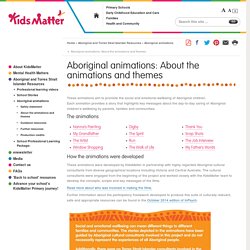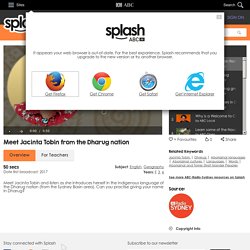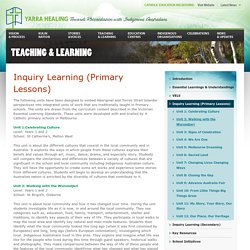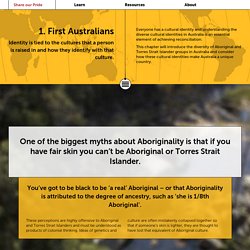

Aboriginal and Torres Strait Islander Resources. This page brings together KidsMatter resources about the social and emotional wellbeing of Aboriginal and Torres Strait Islander people across all four sub-sites: KidsMatter Primary, KidsMatter Early Childhood, KidsMatter Families and KidsMatter Health & Community.

Aboriginal animations: About the animations and themes. These animations aim to promote the social and emotional wellbeing of Aboriginal children.

Each animation provides a story that highlights key messages about the day-to-day caring of Aboriginal children’s wellbeing by parents, families and communities. The animations How the animations were developed These animations were developed by KidsMatter in partnership with highly regarded Aboriginal cultural consultants from diverse geographical locations including Victoria and Central Australia. The cultural consultants were engaged from the beginning of the project and worked closely with the KidsMatter team to develop the concepts, scripts and key messages of the films.
Read more about who was involved in making the films. Further information about the participatory framework developed to produce this suite of culturally relevant, safe and appropriate resources can be found in the October 2014 edition of InPsych. Animation themes Each animation covers one of the following themes: Little J and Big Cuz. Aboriginal Perspectives - Units - AC UNITS.
ABC online education. More info Copyright Metadata © Australian Broadcasting Corporation and Education Services Australia Ltd 2012 (except where otherwise indicated).

Digital content © Australian Broadcasting Corporation 2012 (except where otherwise indicated). Video © Australian Broadcasting Corporation (except where otherwise indicated). All images copyright their respective owners. Text © Australian Broadcasting Corporation and Education Services Australia is licenced under a Creative Commons Attribution-ShareAlike 4.0 International License (CC BY-SA 4.0). Cite this You can use this information to reference this item. Bibliographic details for 'Meet Jacinta Tobin from the Dharug nation': ABC Radio Sydney, 'Meet Jacinta Tobin from the Dharug nation', ABC Splash. Inquiry Learning (Primary Lessons) The following units have been designed to embed Aboriginal and Torres Strait Islander perspectives into integrated units of work that are traditionally taught in Primary schools.

The units are drawn from the curriculum content described in the Victorian Essential Learning Standards. These units were developed with and trialled by 4 Catholic primary schools in Melbourne Unit 1:Celebrating Culture Level: Years 1 and 2 School: St Catherine’s, Melton West This unit is about the different cultures that coexist in the local community and in Australia. It explores the ways in which people from these cultures express their beliefs and values through art, music, dance, drama, and especially story. Unit 2: Walking with the Wurundjeri Level: Years 1 and 2 School: St Brigid’s, Gisborne This unit is about local community and how it has changed over time.
Unit 3: Signs of Celebration Level: Years 3 and 4 School: St Catherine’s, Melton West. First Australians. Local people may have a preference for how they are described, for example at a function or event.

If you’re not sure of a person’s particular language group and can’t find out, it’s usually okay to simply acknowledge them as Aboriginal or Torres Strait Islander. The easiest way to find out is to ask the person themselves – they will see this as showing respect and they’ll appreciate it. Connection with country is crucial to the wellbeing of Aboriginal and Torres Strait Islander peoples. For millennia, when Indigenous people visited the country of others, there would be rituals of welcoming to country. Today, these rituals have a legacy in formal ‘Welcome to Country’ and ‘Acknowledgment of Country’ protocols. Usually a ‘Welcome to Country’ will occur at the beginning of any major public meeting.
Acknowledgements can be done at the beginning of any meeting. Acknowledge the traditional owners/custodians.Pay respect to their Elders past and present. Story105. The Buyungurra who didn't listen - English (F,4,6) TES Australia - Log in or Register. TES Australia - Log in or Register. Search. Skip to content Search results 9 items for yanyuwa Search filters Choose your year(s)

Crackerjack Education. Percy Trezise: One man's passion for Quinkan Rock Art helps preserve Aboriginal cultural history. Updated Interactive: Find out what's depicted in the Quinkan rock art.

By all accounts, Percy Trezise was a bit confronting when you first met him. He wore a pith helmet, a pistol on his hip, and chomped down on a cigarette holder. He moved quickly through the Cape York Peninsula scrub and was often accompanied by his bush mates, including his adventure partner, Aboriginal artist Dick Roughsey. But Percy wasn't just a man's man. Today Percy's sons Matt and Steven are still tramping through the bush under the spell of an obsession which has made the Trezise name synonymous with the oldest art in the world - the legendary Quinkan Rock Art. It is an obsession that has occupied the lives of two generations of Trezise men, but which has come at a cost to relationships.
Cultural history preserved in pristine wilderness The Quinkans are situated in pristine wilderness near Laura, a small town four hours north-west of Cairns. There they cooked, slept and painted. "Dad was indefatigable. Sally Morgan's Australia by Christina Coleman on Prezi.